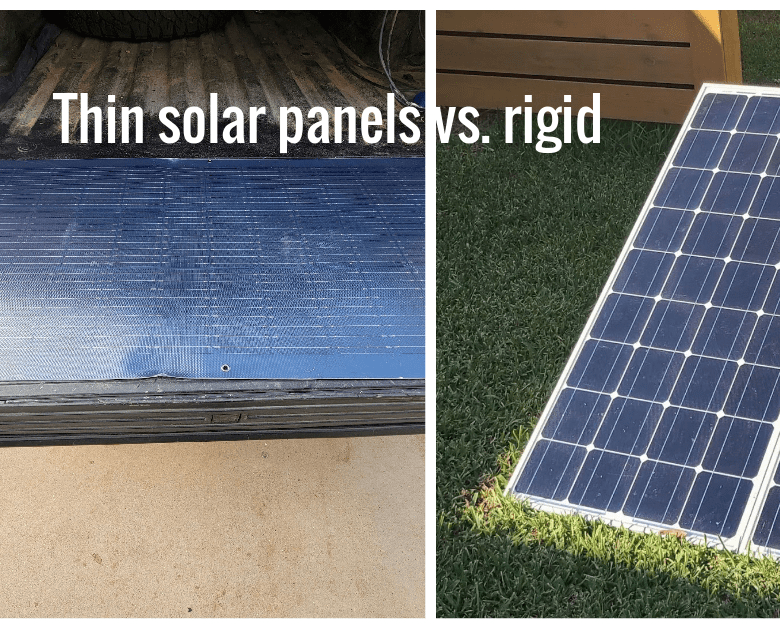For our truck camping solar power setup, a few months ago we tried replacing our two rigid Renogy solar panels (100 watts each) with a thin, semi-flexible panel. By using our new dual input DC-DC MPPT solar charger we can efficiently charge our house battery while driving, so for short, overnight camping trips, one 100 watt panel is enough to give an evening and morning boost to top off the house battery that powers our Dometic CFX-28 fridge.
The scope of our experience is based solely on Renogy products that we’ve purchased.
We aren’t solar power experts, but hopefully our experience with flexible solar panels vs. rigid ones might help inform your purchasing decision if you’re on the fence.
Not As Durable as we Thought – If you’re thinking of replacing your rigid overlanding solar panels with thin ones, and toting them around, you might be disappointed with how they hold up. We love how light Renogy semi-flexible panels are, and they’re just as efficient as rigid solar panels, but the durability the manufacturer claims, that depends…

“But they’re not made for carrying around…they’re supposed to be installed!
True, but they shouldn’t damage this easily!

Flexible Solar Panels vs. Rigid Solar Panels
For longer trips we carry two Renogy rigid solar panels, but have thought of getting one more semi-flexible panel and leaving these at home, mostly because the rigid solar panels are so heavy.
We’ve held off, because we found the flexible panels just aren’t that durable. Yes they’re probably long-lasting when installed on RV or overland vehicle roofs, but not so much for toting around and setting up on a daily basis.

Flexes, But Not in a Good Way – Our flexible solar panel now has large indentations in the sides, caused by using a bungee cord around it (on a hot day). There are stress cracks at the grommets (see lower left of photo below), from being tied to our rooftop tent on a breezy day. The surface of the panels have scuffs from the cables they were stored with in while traveling.


The Bottom Line on Rigid vs. Thin Solar Panels?
Renogy describes the pros and cons of flexible vs. rigid solar panels here on their website, for those trying to decide between the two. When installed permanently on a roof or hard shell rooftop tent, they’re a great way to go, but do require drilling holes. Rigid panels – in our experience – don’t get scratched up as easy and will probably last longer, but are four times heavier.
Durability – Things like tree branches tend to scratch flexible solar panels, especially on hot days when the plastic is softer. If you’re thinking of toting them around to set up temporarily, you might consider placing them on a rigid backer-board. The grommets are only for attachment and aren’t made to take the lateral stress from tie-down cords. Our rigid 100 watt panels are 8 years old and in great shape. We feel strongly that our flexible Renogy panel won’t last as long, at least not using it the way we have.
Cost – We like our flexible Renogy 100 watt panel, but it cost $140 compared to $84 for a rigid one.
Warranty – The material and workmanship warranty for Renogy flexible solar panels is only for 5 years. It is 10 for rigid panels. On their website Renogy lists the warranty for their flexible solar panels as follows:
Flexible – “Panels: 25-year power output warranty: 5 year 95% output warranty, 10 year 90% output warranty, 25 year 80% output warranty 5-year material and workmanship warranty”
Rigid Mono Solar Panels – Performance Warranty: 5 year 95% output warranty 10 year 90% output warranty 25 year 80% output warranty, material and workmanship warranty: 10 years.
We hope this post was helpful if you’re trying to decide between rigid or flexible solar panels. Thanks for visiting!
Related Post: Review of Renogy DC-DC Dual Input MPPT On Board Charger





